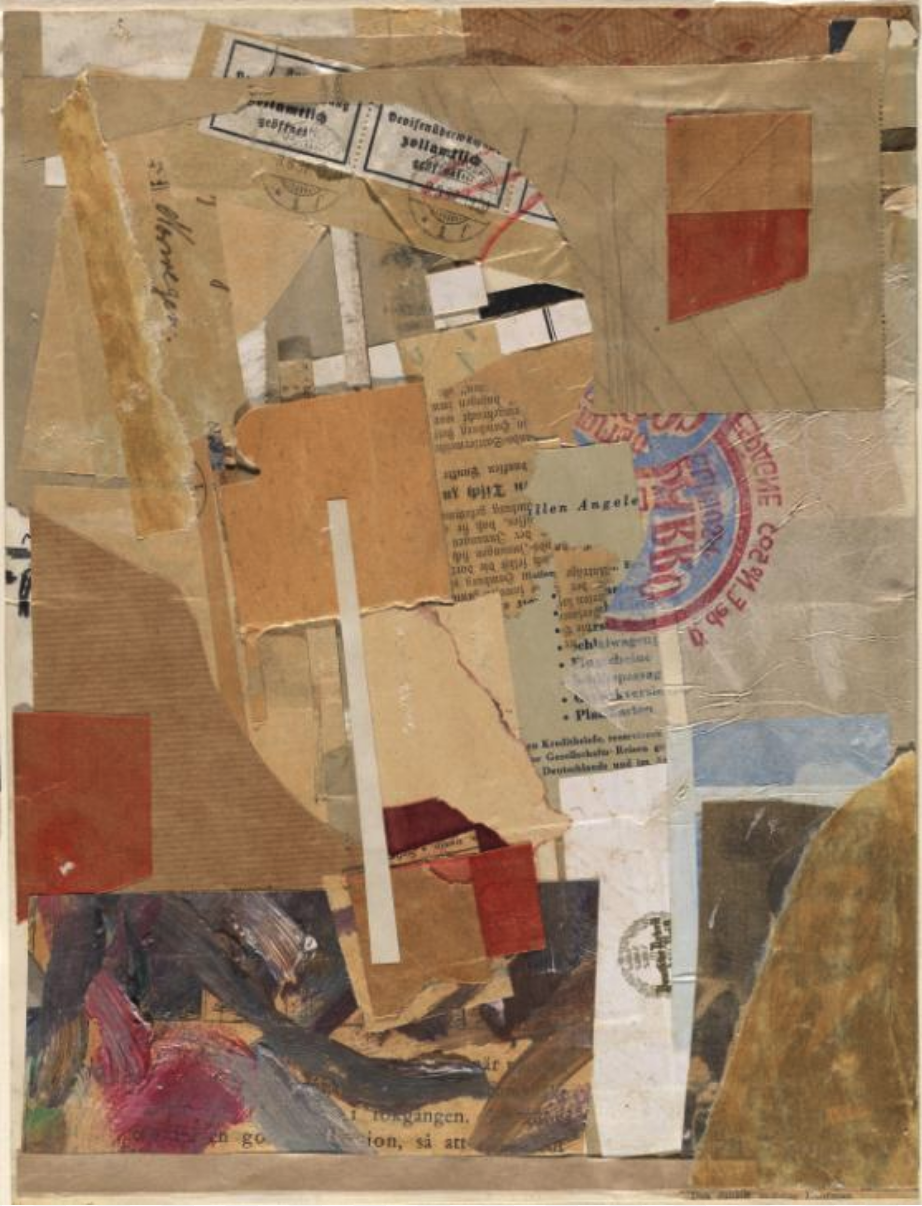
Schwitters collected garbage and found objects from the streets and used them to compose Dadaist collages.

Schwitters collected garbage and found objects from the streets and used them to compose Dadaist collages.

epoxy paints, wooden box, 8.9×6.2in / 22.7×15.8cm
collected materials from street in Busan, South Korea, which was disappearing due to development
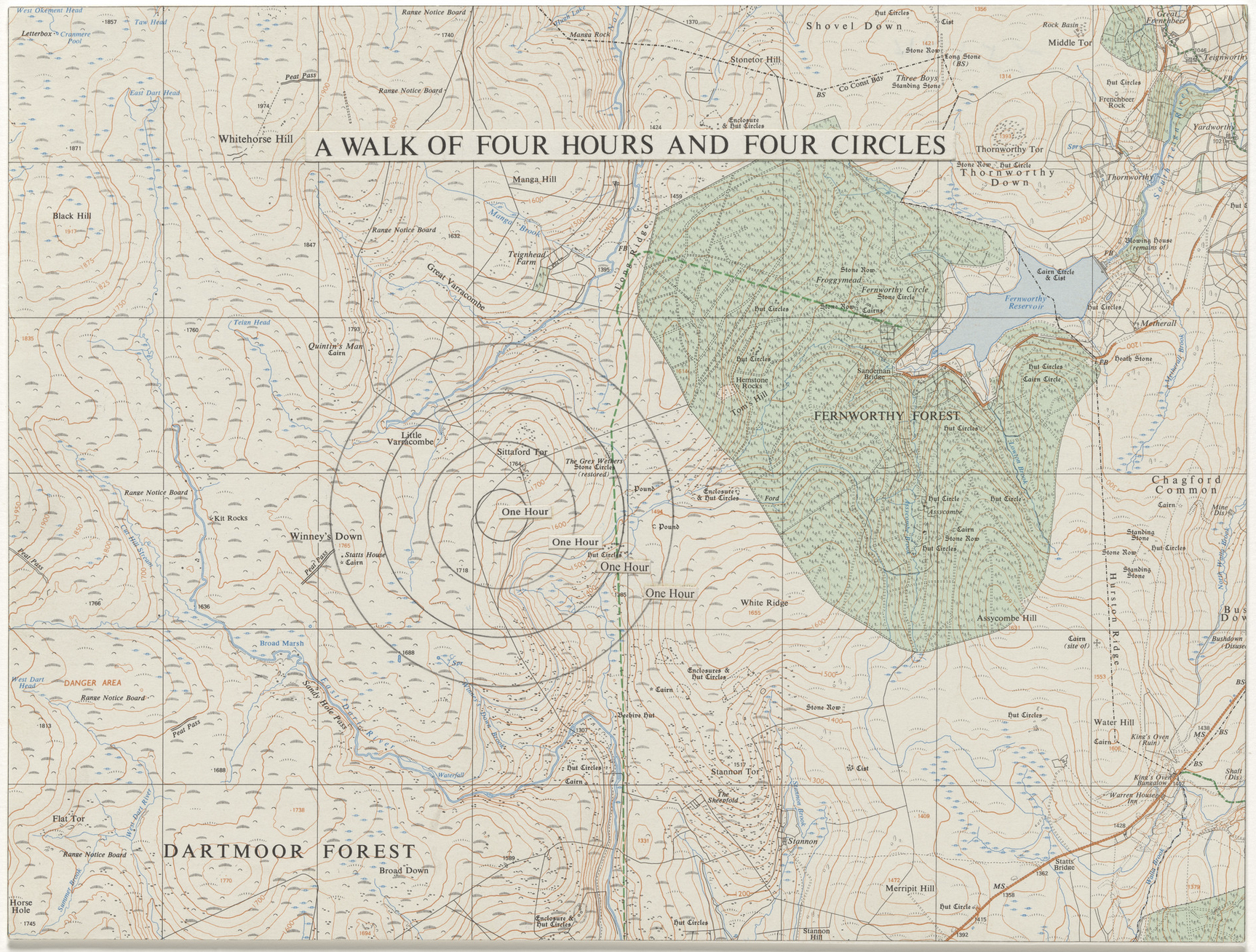
[credit]
Consists of a map with said concentric circles indicated, along with the title. Writer Rebecca Solnit observes, “On the maps the route of the walk is drawn in to suggest that the walking is drawing on a grand scale, that his walking is to the land itself as his pen is to the map, and he often walks straight lines, circles, squares, spirals.” – Wanderlust: A History of Walking. Penguin Books, 2000. Page 270.
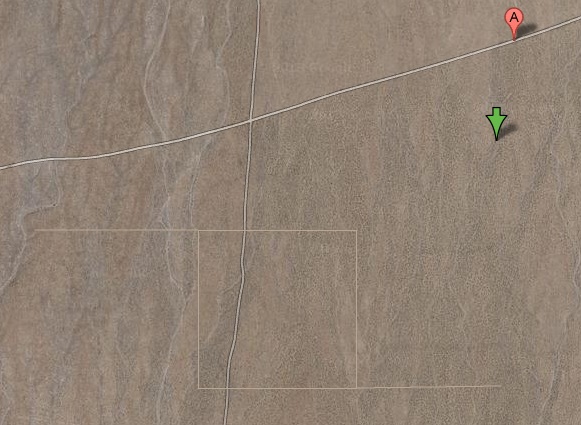
[credit]
“A large, simple etching on the earth, made with four shallow cuts from the six foot blade of bulldozer, two one mile long, two a half mile long, forming a square with half mile lines extending from it. Made in 1969 by the artist Walter de Maria, in a remote location north of Las Vegas, the piece was not maintained, and is only faintly visible today, to some.” [credit]
—
“The question is not whether you can visit Walter De Maria’s Leaving Las Vegas; the question is, does it still exist?
Already in 1972 when discussing the land art project with Paul Cummings, Walter de Maria seemed to emphasize the difficulty of actually experiencing Las Vegas Piece as part of the actual experience of Las Vegas Piece. He’d graded a mile-long square onto a barren desert valley north of the city, and you’d have little chance of even finding it, much less seeing it, much less seeing it all:
it takes you about 2 or 3 hours to drive out to the valley and there is nothing in this valley except a cattle corral somewhere in the back of the valley. Then it takes you 20 minutes to walk off the road to get to the sculpture, so some people have missed it, have lost it. Then, when you hit this sculpture which is a mile long line cut with a bulldozer, at that point you have a choice of walking either east or west. If you walk east you hit a dead end; if you walk west you hit another road, at another point, you hit another line and you actually have a choice.
And on and on for several hours, until your choices and backtracking end in some combination of experiencing the entire sculpture on the ground; declaring victory or defeat partway through; and dying of exposure in the desert because you can’t find your car.” [credit]
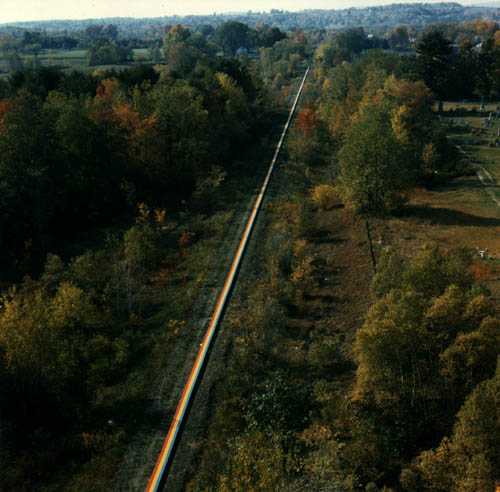
Patriciat Johanson (1940-)
“…functions almost like a piece of the landscape—continually reflecting the changes going on around it. 1600-feet long and painted red, yellow, and blue… at times the entire spectrum was visible due to optical mixing along the borders, and the painted colors were constantly in flux due to changes in the color of natural light. At sunset, for example, when red light was falling on the sculpture the blue stripe turned to violet, the yellow stripe to orange. Because the space-projection literally went beyond the field of vision, movement and aerial views also became particularly important.” – © Patricia Johanson, “A Selected Retrospective, 1969-1973”, Bennington College, Vermont, 1973 [credit]
“Inspired by the enormous canvases of the Abstract Expressionists, Johanson created huge sculptures such as Stephen Long (1968) which went beyond the field of vision and interacted with the environment. ” [credit]
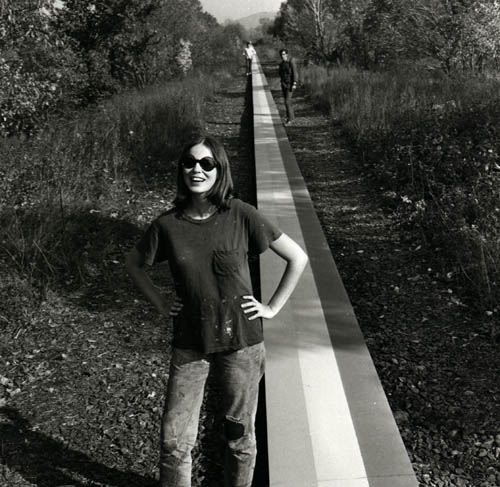
Patricia Johanson and assistants assembled “STEPHEN LONG”
along an abandoned Boston and Maine railroad bed in Buskirk, New York, 1968. [credit]
“Michael Belmore’s Coalescence was conceived as a single sculpture in four parts, [as part of LandMarks2017/ Repères2017 invites people to creatively explore and deepen their connection to the land through a series of contemporary art projects in and around Canada’s National Parks and Historic Sites from June 10-25, 2017.]. Sixteen stones, ranging in weight from 300 to 1,200 pounds, are fitted together and inlaid with copper, then situated to frame the vast distance between the southernmost boundary of the Laurentide Ice Sheet near Grasslands National Park in Saskatchewan, to one of its points of drainage into Hudson Bay in Churchill, Manitoba.
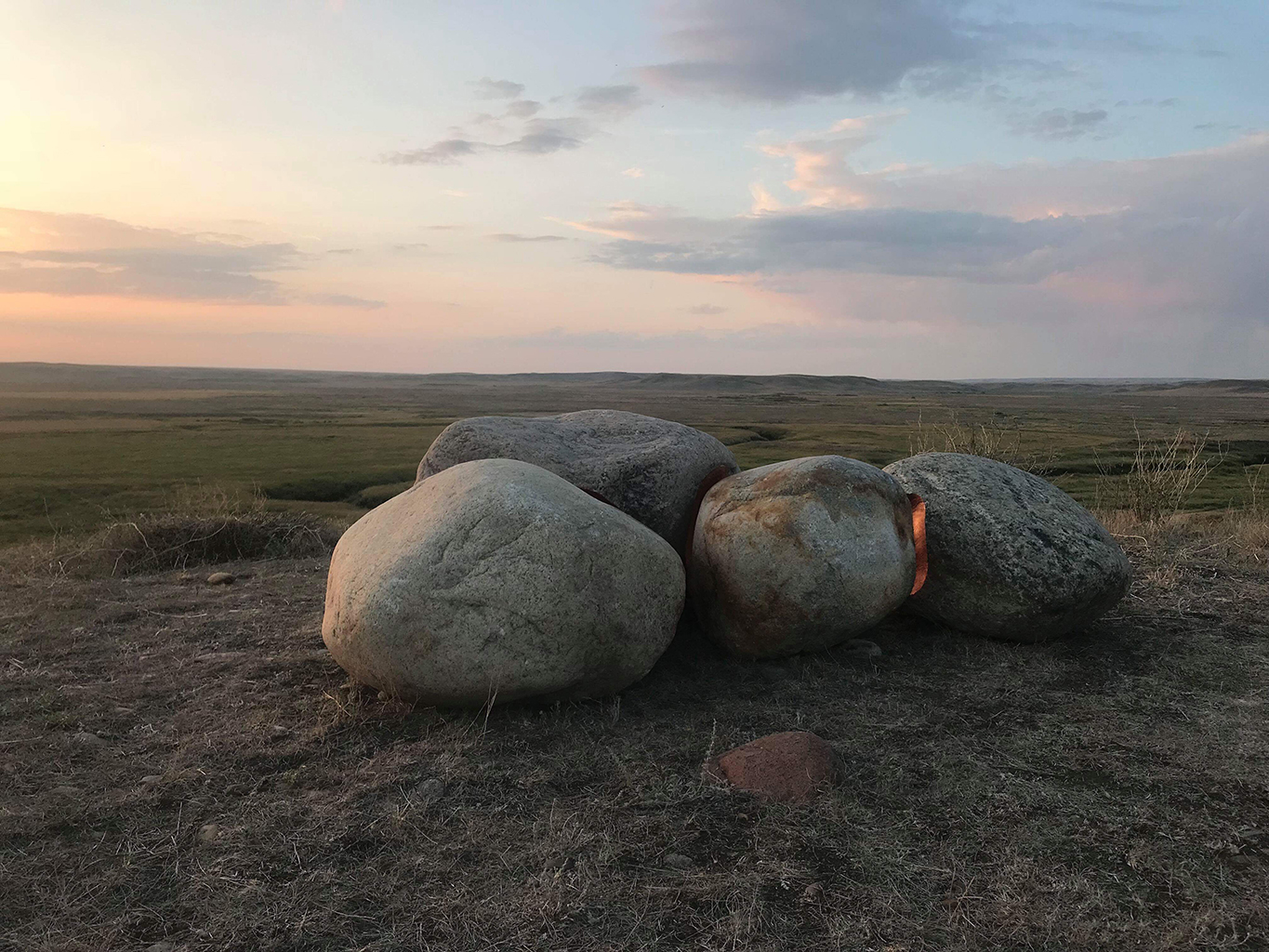
Sites in Riding Mountain National Park and The Forks National Historic Site, both in Manitoba, punctuate the stones’ migration. Together, the four locations mark meeting points between water and land: ancient shorelines, trade routes and meeting places, sites of annual mass migrations of animals, as well as the forced displacement of peoples.
Belmore uses copper as a way to invest the stones with labour and value. The stones come against each other to create a perfect fit, while their concave surfaces move apart slightly to reveal the warm glow of copper to reflect light. Each crevice is filled with a fire that will be extinguished with age, turning brown, then black, and reaching a luminous green hue as it settles into the landscape. They are a marker of how everything comes from the ground and returns to it, and how these processes stretch far beyond human understanding of time.
Belmore has created a moment of connection between deep geological time of stone and the linear human time of labour. On the occasion of the 150th anniversary of Confederation, this connection acts as a reminder of how the timelines of national celebration do not take into account the timelines of the land on which they take place. The stones were going to traverse a land familiar with rising and falling waters to reach their locations, but spring 2017 brought a record snowstorm and a spring melt that washed out the rail line that serves as the main transport artery between Churchill and southern Manitoba.
The political negotiations that followed have left the responsibility for its repair unresolved — part of the continued legacy of colonialism, the challenges of northern transportation and migration, and the importance of international trade routes that go back to Canada’s first trading posts. Belmore’s piece remains intact in Churchill, its splitting and migration halted by the processes that reach out from its conceptual core.” [credit]
Was installed outside the Menil Collection in Houston, Texas, United States.
Image 2: Photo: Tom Vinetz Image 3: Photo: Tom Vinetz
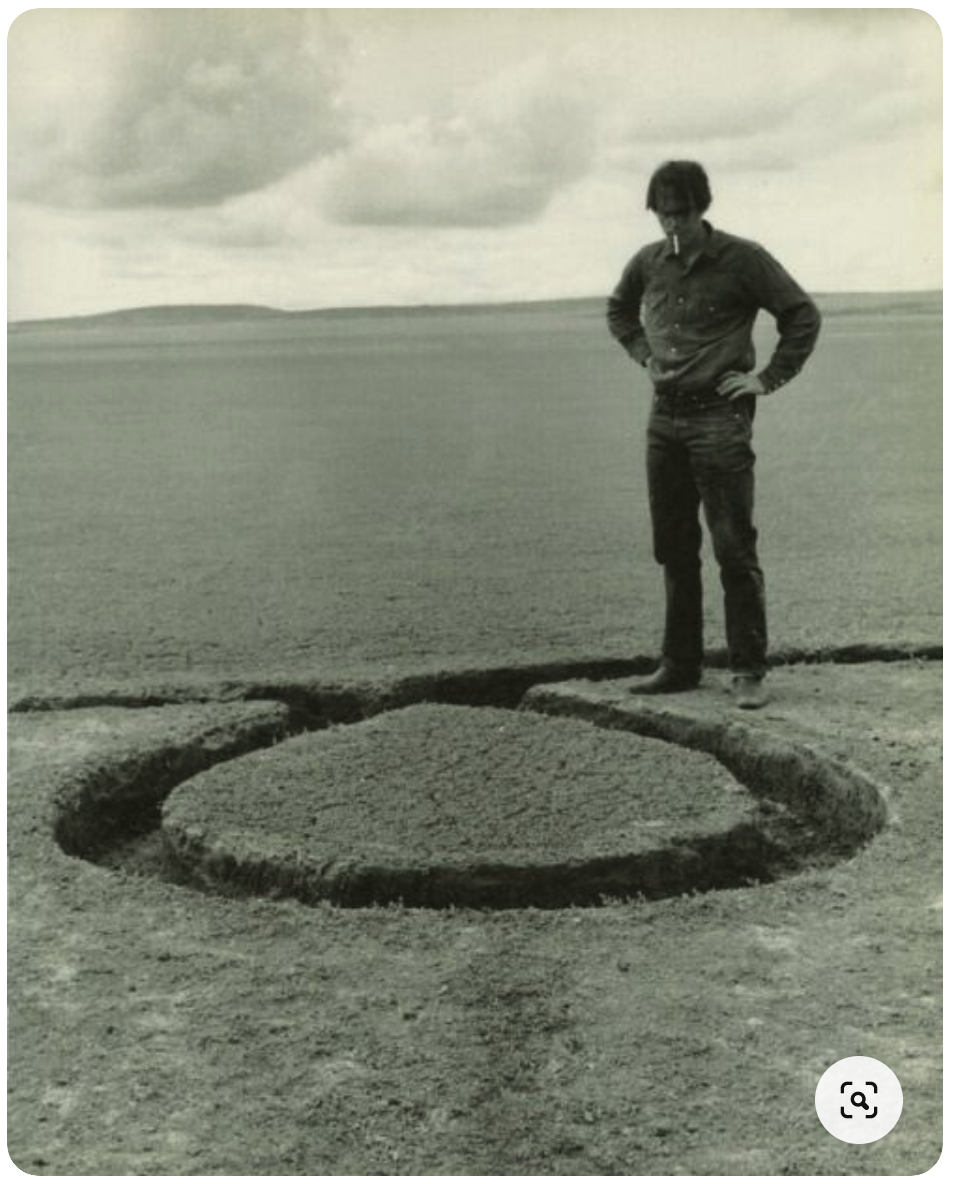
“The first version of this work was the ninth of the artist Michael Heizer’s “Nine Nevada Depressions” made around the state in 1968. This one is a circular loop made in a dry lake bed surface, at Massacre Dry Lake, near Vyo, Nevada. Six tons of earth was displaced, making a one foot wide trench, around 120 feet long, with the loop being 12 feet in diameter. Commissioned by Robert Scull. Apparently, no traces remain.” [credit]
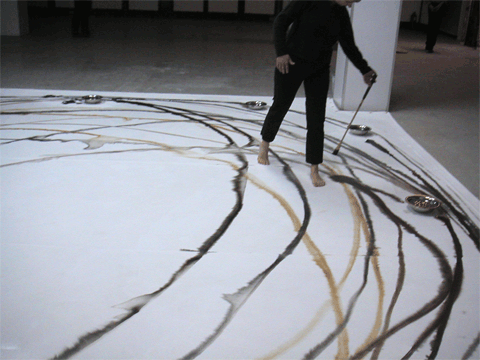
“Duration’s Wisdom II was made on the floor, by using a long handmade paintbrush. Twelve silver bowls were filled consecutively with black ink, brown pigment and water placed in a circle around the canvas. Dipping the brush into the bowls, placing it on the canvas and walking around the painting, she created a long circular, continuous line. Redipping the brush whenever needed, “I simply walked as long as I could around and around the canvas until I could walk no longer.” [credit]
Reg Carremans (1981-) is a Brussels-based visual artist mapping the self and the environment through different media, to encourage critical introspection, (self-)awareness and reflective thought. Interested in humans as geographical beings (walking, landscape, environment, place, territory, cartography), and the artist and artistic processes (identity, basic actions, economy).
“Pathscape is a canvas walk for Sideways, a month-long itinerant initiative for contemporary art and culture. August – September 2012 | Belgium | Walks, canvas patchwork” [credit]
—
“Reg Carremans is a landscape painter who makes his work through walking or rubbing against the environment in which he is in. He was the only Belgian artist to complete the 375km Sideways 2012 Walking and Art Festival route, using canvas on the soles of specially adapted walking boots to gather multiple impressions for a series of ‘landscape paintings’ displayed en route.” [credit]

Athena Tacha, “Double Star: Antares,” Ohio Outdoor Sculpture, accessed April 23, 2022, https://www.sculpturecenter.org/oosi/items/show/598.